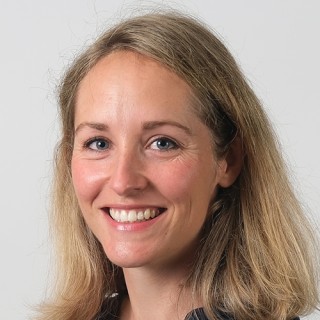Tactical use of proximal sensing tools for the S-map soil survey
Using diggers within vineyard rows is also problematic, with limited access and health and safety concerns putting landowners off. Obtaining observations of the soil profile is, therefore, time-consuming and expensive, so when a decision is made to dig an observation pit, that pit needs to be meaningful and immediately advance our understanding of the spatial soil pattern in the area.
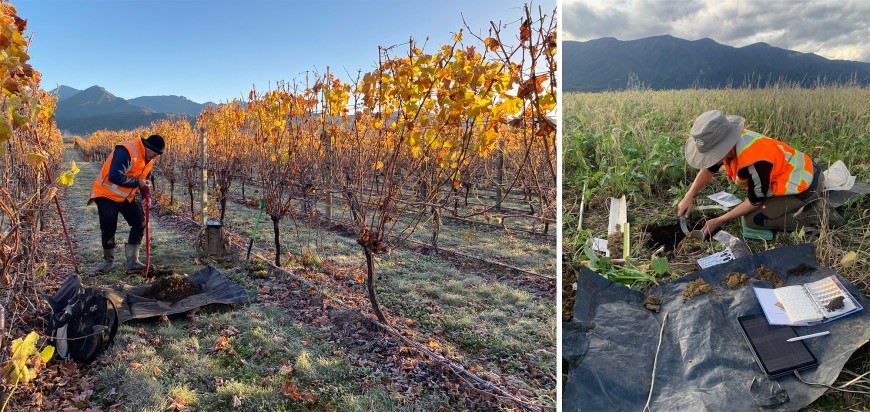
Figure 1. Left: Matt Oliver (Marlborough District Council senior environmental scientist – land) digging a soil observation pit in a vineyard in the Wairau Valley. (Photo: Kirstin Deuss). Right: Manaaki Whenua – Landcare Research pedologist Kirstin Deuss carrying out a soil profile description on land that is being prepared for vineyard development in the Wairau Valley. (Photo: Matt Oliver)
Generally speaking, soils are mapped using traditional pedological techniques, which rely on soil profile observations coupled with landscape analysis. More recently, the advent of sensing technologies has made it possible to drive a mobile sensing platform across a paddock and generate high-resolution, small-scale soil maps using electromagnetic (EM) or gamma-ray (γ) sensors. This is typically done to provide information for precision agriculture, but is usually very difficult to apply to larger survey areas.
In a project with Marlborough District Council, we applied a novel approach in the Wairau Valley that tested the benefit of merging these two soil-mapping pathways and leveraging their respective strengths. Using pedological understanding of soil–landscape relationships, as well as aerial imagery and LiDAR, transects were strategically selected along the valley, each crossing a range of landform variations that were expected to be regulating the soil pattern. EM and γ data were collected along the transects and analysed in real time in the field. The direct feedback from these sensors allowed immediate identification of the boundaries representing important changes in the soil, and, importantly, enabled targeted and rapid selection of where to expend time digging a soil pit.
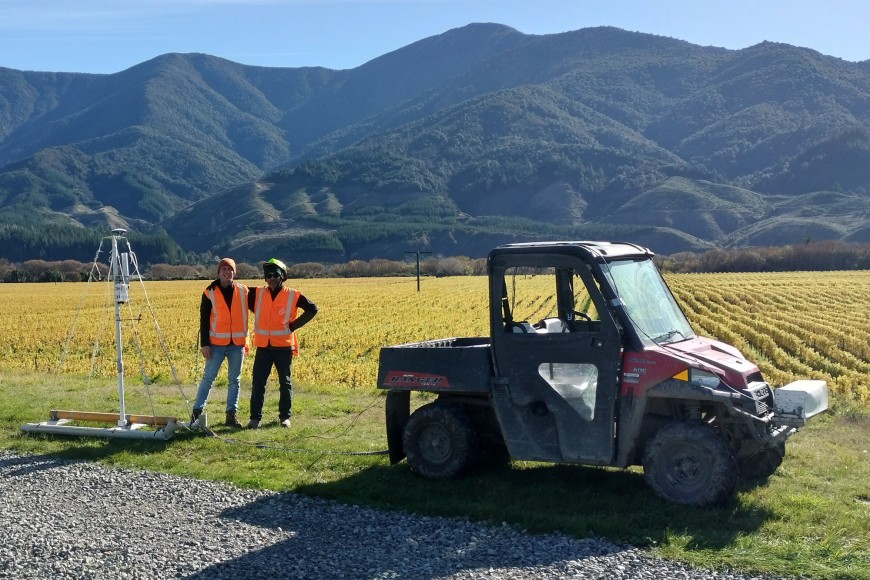
Figure 2. The mobile soil-sensing platform used in the survey. The gamma radiometer is located in the grey box mounted at the front of the vehicle. The EM instrument (yellow) is towed on a plastic sled behind the vehicle, with a real-time kinetic positioning (RTK) global navigation satellite system (GNSS) receiver mounted on top of the sled. Pictured behind the sled are Marlborough District Council environmental science technician Zeke Hoskins (left) and Manaaki Whenua – Landcare Research technician Kishor Kumar (right). (Photo: Pierre Roudier)
The variation identified by the sensors was generally logical and provided confidence in our pedological interpretation of the soil patterns. However, there were instances where the sensors showed utility outside their intended scope and identified important variation that was not expected. For example, an apparently uniform terrace formed from river deposits was identified by the EM data as having two significantly different soils (Figure 3). Targeted digging identified an unexpected area of deep, silty soils derived from windborne dust (loess), which occupied a large part of the otherwise stony terrace surface (Figure 4).
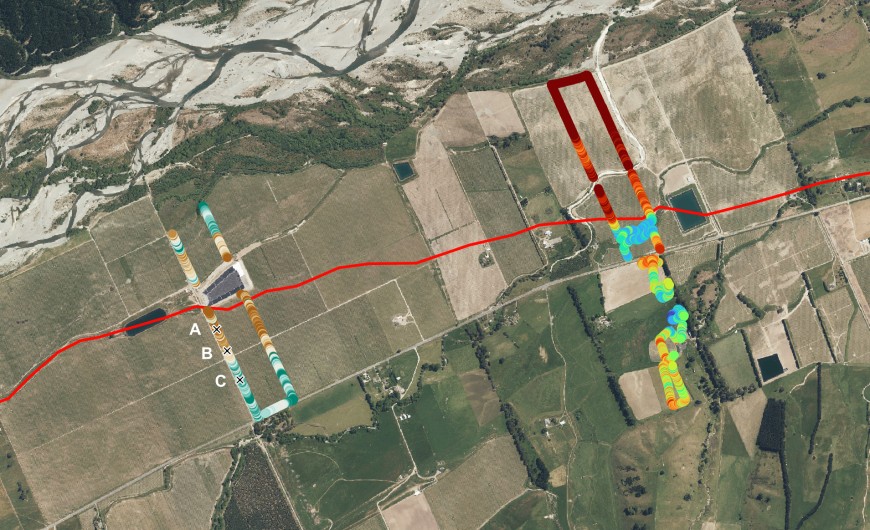
Figure 3. Two survey transects in the Wairau Valley. The Wairau River can be seen to the north, with its floodplain extending down to the red line. An elevated, older terrace extends from the red line south. The left transect shows EM data with distinctly different signals on the older terrace, which were unexpected. Soil observations at points A, B and C confirmed that the EM was identifying significantly different soils. The right transect shows gamma data, which clearly identify differences between the floodplain and the older terrace. (Photo: Kirstin Deuss)
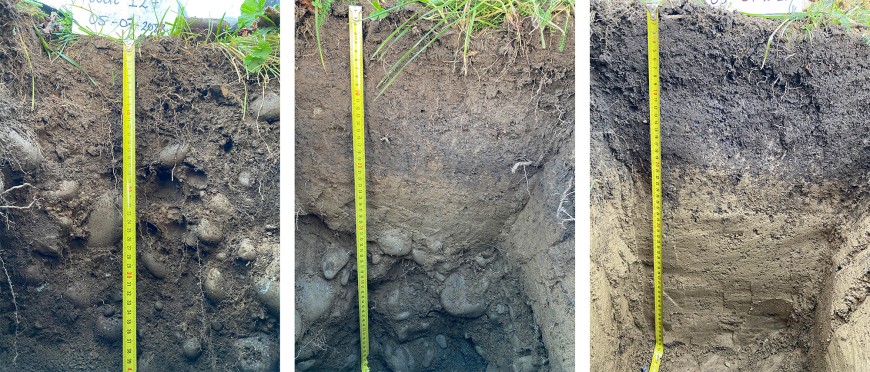
Figure 4. Soil profiles at points A, B and C. Soil A shows a shallow, stony soil derived from river deposits. Soil C shows a deep, silty soil, derived from windborne dust (loess). Soil B shows an intermediate soil, with silt overlying gravels. (Photo: Kirstin Deuss)
An important lesson from our research was that soil-sensing data are best used alongside field pedology in an iterative fashion. In one example, a significant difference in EM signal in a vineyard block was shown to be the result of soil disturbance from the demolition of a large area of buildings prior to 1974, the debris of which had apparently been worked into the surrounding soil. Such examples demonstrate why the sensors should not be used alone to produce a soil map, and why pedological expertise is vital for the appropriate interpretation of soil sensor data.
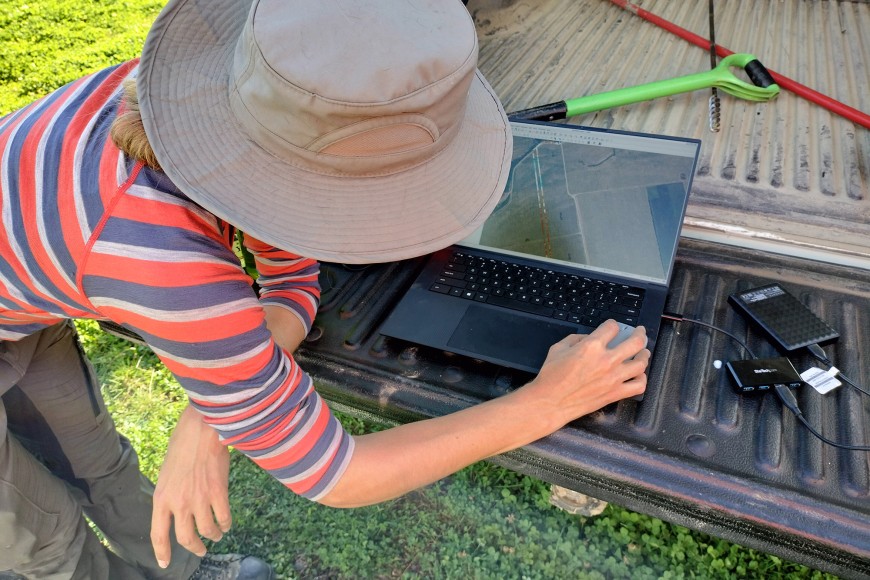
Figure 5. Manaaki Whenua – Landcare Research pedologist Kirstin Deuss analysing real-time data while in the field in order to best position the next soil pit. (Photo: Pierre Roudier)
For Matt Oliver, this work was a crucial part of Marlborough District Council’s efforts to optimise land and water management in the valley. ‘The soils of the Wairau Valley were last mapped in 1939. This area is a rapidly developing area for viticulture and as such has a high requirement for detailed soil information to inform irrigation water allocation and system design,’ he said. ‘It has been great to work alongside Manaaki Whenua’s team, using the latest technology to accurately and quickly remap these areas to meet our increased demand for high-quality soils information,’ he added.
This approach is an example of how pedological expertise and proximal soil sensing can be combined to make progress in soil mapping. These tools are in development, and future work aims to test their utility in other soil landscapes.
